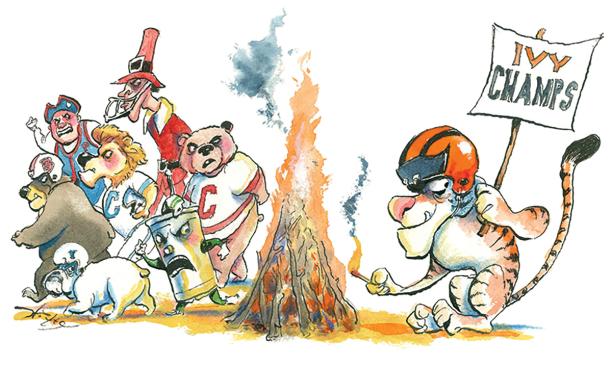
As my friends and family will attest, I am a big Princeton sports fan. I was in Portand, Oregon, in 1965 for the Final Four (before it was called the Final Four) and in Louisville in 2023 for the Sweet 16. I was in the stands when our football team went undefeated in 1964, and again in 2018. I am also a loyal Princetonian. I attend Reunions every year, and I am a strong believer in Princeton’s many traditions. Yet, there is one tradition that I believe has outlived its usefulness — the Big Three football bonfire, the one we have when we beat Harvard and Yale in the same season.
You might ask why. Simply stated, the “Big Three” has become a fiction. Harvard’s chief rival is Yale, and vice versa. Only Princeton seems to think that the Big Three is a thing. To Harvard and Yale, Princeton is an afterthought. We’re the junior partner. We’re the kid brother that the big kids have to watch because mom and dad are going out to dinner.
There once was a time when the Big Three was important. The first reference I can find is in a headline from the Nov. 10, 1889, issue of The Boston Globe. But the designation must have been in use earlier, as the context of the article makes it clear that the term was widely known. In those days, the games that Princeton, Harvard, and Yale played against one another were sold out and widely covered, often on the front pages of major newspapers, and for good reason: 35 of the first 42 national football championships were awarded to a member of the Big Three. In the late 19th century, the Princeton-Yale game, played on Thanksgiving Day in New York City, was a major sporting event.
Over the succeeding years, the prominence of the Big Three diminished, and in 1954, the presidents of the eight Ivy League schools formalized an agreement to “deemphasize” football (no athletic scholarships, no postseason games, etc.). Still, in my day, the 1960s, the Big Three meant something. We didn’t have an official “homecoming”; the big game was against either Harvard or Yale, depending upon who was playing at Princeton. Of course, on the last Saturday of the season, Yale and Harvard played each other. After all, they were the senior partners.
Every year, our athletic program produces more league champions than any of the other Ivies. Princeton should never, ever be the junior partner. It’s unseemly.
More recently, the Ivy League schedule makers decreed that both Harvard and Yale would no longer alternate their Princeton appearances. Now, they’re either both here or both away. Now, we have to declare a homecoming, and every other year it’s against someone other than Harvard or Yale. Last year, both Harvard and Yale visited Princeton Stadium. The total attendance for the two games: 15,502. November’s Harvard-Yale game in New Haven drew 51,127 fans. Yale didn’t even bother to send its band to Princeton. If there ever was a rationale for a Big Three bonfire, it’s long gone.
For the past 13 years, U.S. News and World Report has rated Princeton the top university in the country. The Wall Street Journal and Forbes rate us number one as well. Every year, our athletic program produces more league champions than any of the other Ivies. Princeton should never, ever be the junior partner. It’s unseemly.
I value the bonfire tradition. It is a wonderful community-building event with a rich history, but it is time for it to be reimagined. These days, most fans feel that winning an Ivy League title is the mark of a successful season. So, by all means, let’s have a bonfire, but let’s have it when we win the Ivy football crown. Yale and Harvard are, and will remain, big rivals, but let’s be real, three’s a crowd.
I realize that this radical suggestion may provoke a Mr. Smith Goes to Washington avalanche of emails. Feel free to opine. And while you’re writing, how about some ideas for a women’s athletic bonfire?
Henry Von Kohorn ’66 will be in the stands at Princeton football’s home opener against Howard on Sept. 28.
